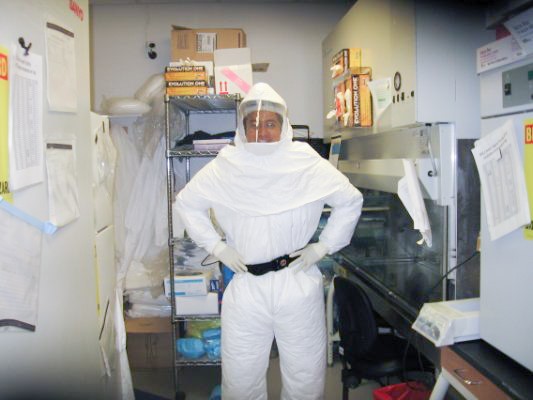Researcher aims to eliminate glanders disease through new vaccine

Dr. Apachai Tuanyok outside of his laboratory in the UF Emerging Pathogens Institute. (Photo by Thom Sanders)
By Thom Sanders
In 1915, in a basement laboratory in Maryland just six miles from the White House, two German spies were manufacturing biological weapons.
The spies, brothers Anton and Carl Dilger, were culturing glanders and anthrax. Both of these deadly pathogens are zoonotic, diseases that can be transferred from animals to humans. Once produced, the cultures were passed to German saboteurs who infiltrated nearby ports to infect horses and mules bound for Allied forces in Europe.
Today, in 2018, Dr. Apichai Tuanyok, an assistant professor in the UF College of Veterinary Medicine’s department of infectious diseases and immunology, is running quite a different laboratory with quite a different goal. Housed in the UF Emerging Pathogens Institute, Tuanyok’s lab is trying to disarm glanders once and for all.
While people can get the disease, glanders primarily affects horses, as well as donkeys and mules. The disease can also be naturally contracted by other mammals such as goats, dogs and cats, according to the Centers for Disease Control and Prevention. The CDC website states that the bacteria that causes glanders, known as Burkholderia mallei, are transmitted to humans through contact with tissues or body fluids of infected animals.
Although glanders has been eradicated from North America, the pathogen still looms as a possible threat. It might not be a household name like anthrax, but glanders is categorized similarly by the CDC. The disease’s underlying pathogen, Burkholderia mallei, is “classified as a Tier 1 (top tier) Select Agent,” meaning that the disease has significant biowarfare potential, Tuanyok said.
Tuanyok was the corresponding author on a recent paper published in Vaccines outlining early steps toward a safe and effective glanders vaccine. Using biologically safe bacterial strains — strains that are genetically similar to glanders but non-pathogenic to humans —Tuanyok and his fellow researchers were able to create a vaccine that prevented lethal glanders in mice.

Tuanyok is shown at his former institution in 2006, shortly after he began researching glanders. Special precautions are necessary when researching glanders because Burkholderia mallei, the bacteria that causes the disease, is classified by the CDC as a Tier 1 select agent.
The researchers induced the biologically safe surrogate bacteria to produce outer membrane vesicles, or OMVs — biological nanoparticles that contain antigens, molecules that can prompt immune reactions. Using the OMVs and their associated antigens, the researchers were able to create a vaccine that induced protective immunity in mouse subjects.
As the paper points out, a vaccine produced from both biologically safe surrogates and OMVs has significant safety advantages over other options. Because the bacterial strains used to produce the vaccine are not considered human pathogens, it is unlikely that the resulting vaccine would pose a threat to humans. In other studies, researchers have produced vaccines that protected mice from glanders, but the types of vaccines used presented too much of a safety concern to proceed to human testing.
Humans have recognized the threat posed by glanders for thousands of years. As the authors of the paper remind us, both Hippocrates and Aristotle referenced the effects of the disease.
Unfortunately, the pathogen remains and may be re-emerging. In addition to concerns related to biological warfare, glanders could be re-establishing itself as a more conventional pathogenic threat due to the global movement of livestock.
Although the vaccine Tuanyok and his team produced prevented lethal glanders in mice, it “needs to be tested in another animal model for efficacy before it can be tested in humans,” Tuanyok said.
If their research leads to a human vaccine, Tuanyok and his research team will have neutralized a disease that has plagued livestock and humans for millennia. In the meantime, “research toward vaccine development for glanders is a top priority,” Tuanyok said.












